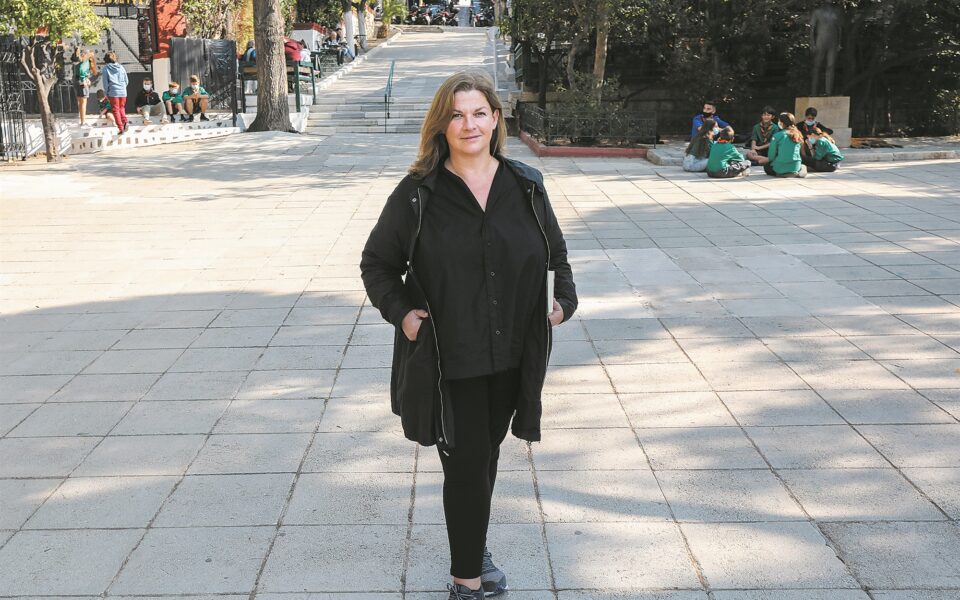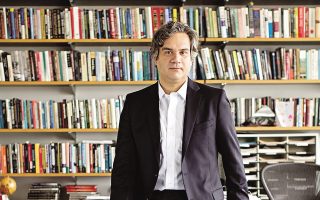Athens: A city that cannot be redrawn overnight
Landscape architect talks to Kathimerini about the planned Panepistimiou Street revamp and the ‘secrets’ of a sustainable city

“A comprehensive plan for Athens is not something that can be done overnight. It’s a long-haul proposition that demands prioritized and orchestrated urban interventions, which then need time to mature. In this regard, the Panepistimiou Street revamp is one of the first acts in a lengthy process,” Helli Pangalou, a respected landscape architect whose work graces public spaces, office buildings, multipurpose venues and private gardens in Greece and abroad, tells Kathimerini.
Her portfolio includes major projects like the Stavros Niarchos Foundation Cultural Center and the Faliro Bay revamp, among others. In cooperation with the Athens Municipality’s Technical Service and architect Androniki Xystra, Pangalou’s firm conducted the study on the widening of the sidewalks on downtown Panepistimiou Street, along its length from Syntagma to Omonia Square.
The Grand Walk came under fierce criticism. Were you at all influenced by all that negativity when you agreed to take part in the Panepistimiou Street project?
Interventions in sensitive areas that signify life and movement, but also have an emotional resonance, will always spark intense reactions and even fierce criticism. We were not a part of the pilot phase of the Grand Walk, but the fact that mistakes were made and it became so negatively charged taught us this: that sensitive spaces should not be avoided because we don’t want to become embroiled in public criticism and frictions, but, instead, demand greater analysis, involvement and engagement. In cooperation with the Municipality of Athens’ Technical Service, its scientific advisers and traffic flow management experts, we took all the different factors into account so that we could take a comprehensive approach to upgrading a sensitive and iconic city location. This is, of course, the challenge in every project, regardless of scale.
Just some of the complaints made by residents about the Grand Walk concern its impact on traffic, the fact that it takes up most of Vassilissis Olgas Avenue and the choice of palm trees for the big planters adorning it. Would you care to comment?
The Grand Walk was an introduction to a contemporary and global reality regarding sustainable, resilient cities. It is already happening in major urban centers abroad. As a trend, it expresses a vision of a city where cars gradually disappear, public transport increases, bicycles become the norm and key arteries are pedestrianized, among others.
You mentioned bicycles. The new plan for Panepistimiou has come under fire for not including a bicycle lane. What exactly is foreseen in this regard?
The principles of sustainable mobility that are already being implemented in most European cities seek to cultivate the idea that bicycle culture is synonymous with the needs of a 21st century citizen. The main thing that needs to happen before you develop a bicycle network in a densely built urban center is make sure it can connect to a bigger network of bicycle lanes, which is something Athens does not have right now. Even though Panepistimiou’s topography would allow it, we did not want to create zones that were cut off, that led nowhere and that violently thrust the cyclist back into the flow of traffic. What we want is for cyclists bringing their bikes to Panepistimiou on the metro to be provided with a complete cycling narrative that will safely take them to different neighborhoods, and under the best circumstances. So, when these circumstances exist for a wider bicycle network across the city, Panepistimiou will then be able to welcome a vital component, along the part between the sidewalk and the planting zone.
There’s been a lot of discussion about the plan to plant plane trees along Panepistimiou. Why did you choose this type of tree?
It’s a type that we come across a lot in Athens and, perhaps, often overlook. There are already 50 plane trees on Panepistimiou. The fact that they provide shade, especially in a city like Athens that suffers from heatwaves, and their vital effect on the area’s immediate microclimate, were the main reasons why we chose them. They will give Athenians relief from the heat, while also creating beautiful images and memories.
The criticism is mainly focused on their need for abundant water and their expansive root systems. How do you respond?
The plan foresees the installation of sustainable subterranean drainage systems that will also serve the city as a whole. They will allow for the gradual absorption of water and also help the city’s drainage system cope with flooding. Moreover, they will collect and filter rainwater. Last but not least, this water will be contained close to the tree’s root system and will slowly seep up to its higher extremities, emitting cool air and dispersing warm airflows. As far as their root systems are concerned, they will be contained by special barriers that are used in all modern urban tree plantings.
What kinds of trees and plants are suitable for Athens? And how do you think the city should go about becoming greener?
Athens is suited to plants in the Mediterranean lexicon and which we already see on its streets, like planes, carobs, mulberries, bitter oranges, Judas trees, acacias, holm oaks and olives. A city’s bioclimatic evolution can be accomplished in many different ways, even using spaces that are not regarded as ideal for greenery. Planted rooftops, for example, is one of the modern approaches. In a city like Athens, with its flat rooftops, planted roofs could give shape to a “floating” ecosystem that would stretch above the city’s buildings like a horizontal, microclimate blanket. As green spaces, they also absorb solar radiation and effectively offset the urban heat island phenomenon. Furthermore, they reduce the temperature of the air and hard surfaces, thus improving the temperature inside buildings and reducing their energy dependence by reducing their need for air conditioning. Thanks to photosynthesis, moreover, they absorb carbon dioxide and produce oxygen. Last but not least, they form a new and pleasant space that is created by exploiting an existing one.
However, I would like to note that the presence of greenery is not so much a matter of quantity as it is of quality and maintenance of the green spaces we want for our city. Little is as sad as the sight of a beautifully designed, well-organized park gradually falling into ruin. Bearing in mind environmental and climatic factors, I would say that an ideal solution for Athens would be complementary interventions that would redefine, design from scratch or improve parks, public squares and other, smaller open-air spaces that could be adapted to different uses and needs, that contribute to the creation of microclimates and that help protect against the unusual weather we have experienced recently. Of course, interventions on the metropolitan scale remain essential because they define the trend and point the way forward for the city.
Some argue that we’re being treated to piecemeal plans rather than a comprehensive plan for Athens that will look at where it will be in 50 years’ time.
I agree with this view, as a citizen, but I must also note that a comprehensive plan for Athens is not something that can be done overnight. It’s a long-haul proposition that demands prioritized and orchestrated urban interventions, which then need time to mature. In this regard, the Panepistimiou Street revamp is one of the first acts in a lengthy process and not a piecemeal action that does not belong to a bigger vision for a contemporary city and for the Athens of the future.
As a resident of Athens, what do you feel is its biggest problem, on a day-to-day basis?
It’s the fact that there appears to be a third element coming between us and the essential Athenian landscape, which does not allow us to appreciate its uniqueness and the truth of this truly energetic urban universe. This element has to do with how relations between citizens are conducted, which, unfortunately, is defined by a lack of respect and empathy, and an inability to create a society that exists together, with respect and simple courtesy. These things, though, appear first in the space and then in the state of living, so it is easy to argue that one of the reasons why, as citizens, we behave as we do is perhaps that the center of Athens, with its plethora of vehicles and its awkward arrangement, is not always nice to us – indeed, it is often quite ruthless.





